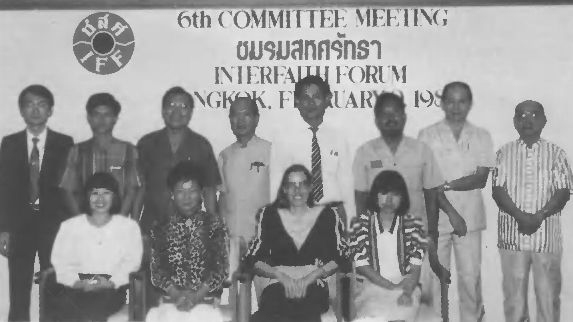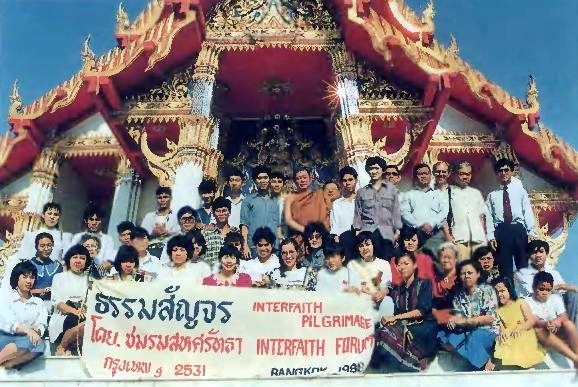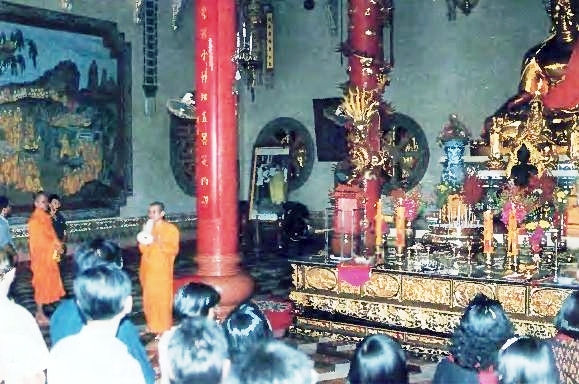![]()
The Words of the McLackand Family
|
|
The Words of the McLackand Family |

The
sixth committee meeting of the Interfaith Forum. Professor Kirti
Bunchua stands third from left. Ursula McLackland is seated center.
In the beginning of 1987, inspired by the success of the interfaith movements in Malaysia and the Philip pines, my regional director Rev. Byung Wooh Kim asked me to initiate the same kind of movement in Thailand.
On the base of Father's worldwide foundation, I contacted various scholars who had attended some of our movement's international conferences and had expressed their concern for religious harmony. Once I found one or two key people who were truly committed to the goal of religious unity, our work began to progress very quickly. Two well- known professors, Professor Kirti Bunchua from Chulalongkorn University in Bangkok and Dr. Saeng Chandrngarm from Chaing Mai University, who had been very active in previous efforts to generate inter-religious dialogue in Thailand, were interested in working with us.
All of the earlier efforts toward Buddhist-Christian understanding had unfortunately ended in failure, leaving behind resentment, suspicion, and frustration. In order to achieve successful dialogue this time, we agreed to begin with only a small group of concerned individuals who we felt could become leaders of an interfaith movement. We held our first Interfaith Conference on July 4, 1987. Although we originally planned for only 10 or 15 people, to my surprise 30 people attended the conference. Most of them had had contact with the Unification movement in some way previously.

The
highlight of the second Interfaith Pilgrimage was a visit to Wat
Thammamongkol, a huge Hinayana Buddhist temple.
Professor Kirti, the moderator of the conference, gave some opening re- marks and introduced the three guest speakers, Dr. Saeng (Buddhist), Bishop Ratna (Catholic), and Dr. Arong (Muslim), who each spoke on the topic "Common Ground of the Various Religions." Before lunch, we showed the video
"One God, One Truth, Many Paths." Father's vision for the Youth Seminar on the World's Religions touched the hearts of everyone deeply. After lunch, all the participants introduced themselves and agreed to set up a committee consisting of two representatives of each religion, in order to select a chairman and discuss further steps towards inter-religious harmony.
I was amazed at the spirit and the warm atmosphere of the conference. The need for religious harmony was so clear to each participant that everyone tried very hard not to affront any other person. I felt that this conference was possible only on the foundation of Father's victory in the spirit world, causing the breakdown of the barriers that exist between the religions.
Since then we have held seven interfaith committee meetings, as a result of which we founded the Interfaith Forum (IFF), with Professor Kirti as its chairman. Its executive committee consists of 21 members, representing all the major religions in Thailand. We have completed the constitution of the IFF as the platform for our work, and 200 people have already signed up for membership. Our goal is to increase membership to 1,000 by the end of this year.
Our monthly committee meetings have helped create a close heartistic bond among the committee members.
During the first two committee meetings, we introduced videos on the Religious Youth Service (RYS) and the Assembly of the World's Religions (AWR), which left a great impression on the audience. Since then, at each meeting a representative of a different religion takes the opportunity to present the views of his or her faith, followed by a stimulating discussion. When Dr. Lek Thaveetermsakul, president of the Unification Church in Thailand, explained about the Unification movement, he was asked who the Unificationists believe Rev. Moon is. When he answered directly, "the Messiah," everybody was quite satisfied with that answer and no more questions about the issue followed.
Our first community activity was in assisting the Religious Club of Chulalongkorn University, the most prestigious university in Thailand, with a special exhibition about religious unity. We arranged for speakers of various faiths to speak about "Youth and Religion." The members of the Religious Club were grateful for our support and impressed by our members' dedication. We also helped the Dharma Center of the same university find knowledgeable speakers for a seminar on "Mass Communication for Morality," in which professors from all the universities in the country participated. Cooperating with existing groups and institutions helped the IFF gain wider recognition.

A
guided tour of a Mahayana Buddhist temple in Bangkok during the first
Interfaith Pilgrimage.
On December 19, 1987, we organized the first Interfaith Pilgrimage. I originally planned this project only for home members arid associate members of our church and for people in my husband's home church area, but when I mentioned the idea to Professor Kirti, he was so excited that he not only agreed to lead the pilgrimage but he also invited students, teachers, lecturers, and members of many different religious circles to the event. He even announced the project on his radio program!
Eighty-five people gathered for the pilgrimage. We visited a Chinese temple (Mahayana Buddhist), which is very different from a traditional Thai temple (Hinayana Buddhist). We were welcomed by the mother superior and the sisters of the Mother Mary School. Most of the participants had never even set foot in a Christian church before. The pilgrimage was concluded at the headquarters of the Unification Church in Thailand. The response was overwhelmingly positive, and many filled out IFF membership forms.
The second Interfaith Pilgrimage, held on January 31, 1988, led 55 participants to a very unique Thai temple, Wat Thammamongkol, which is 14 stories high, and to an Islamic mosque.
In March we issued the first "Interfaith Newsletter" in order to keep all members informed about the current activities of the Forum, as well as to broaden their knowledge about the various religions. We are planning a larger theological conference and a social service project for young volunteers of all faiths to be held later this year.
I have found interfaith work to be very effective for our home church work. The Thai people, who are 95 percent Buddhist, generally have a negative impression of Christianity. If the people have the opportunity to learn about the variety and beauty of all the religions, their hearts can gradually open to receive the unifying understanding of the Principle.